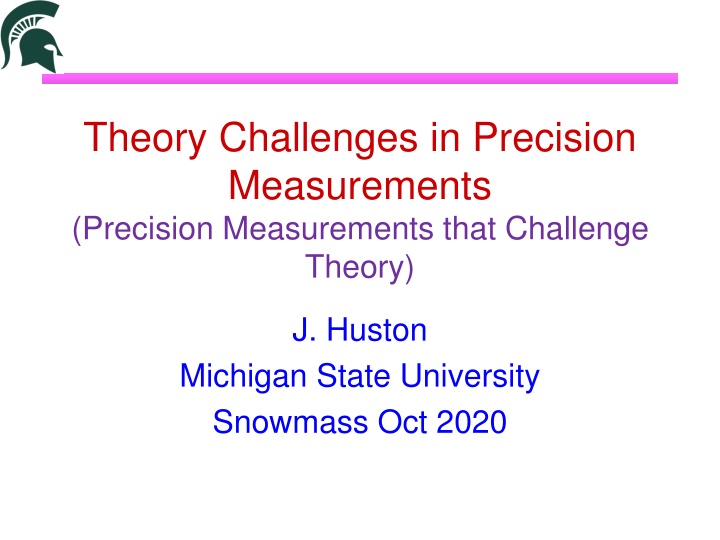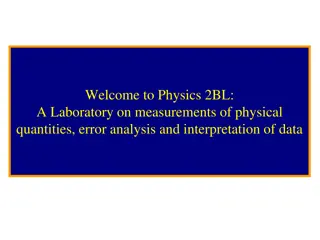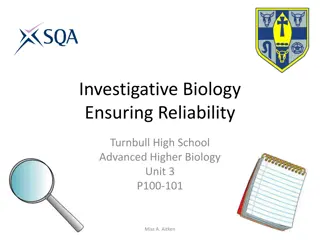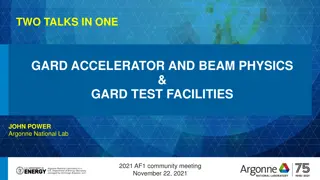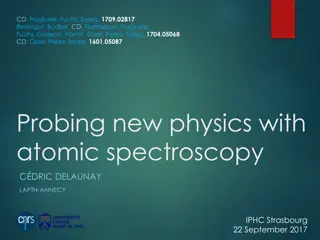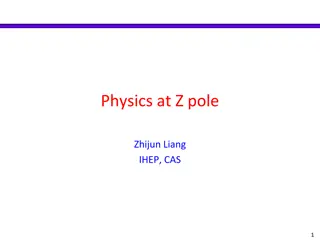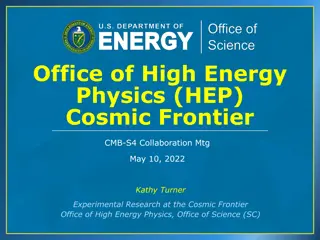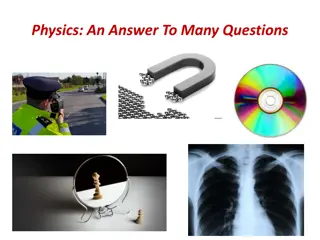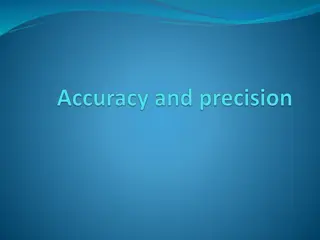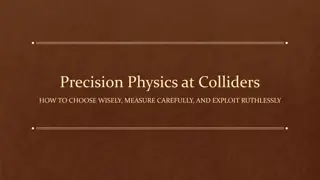Advancing Precision Measurements in High-Energy Physics
Exploring the challenges and advancements in precision measurements for high-energy physics experiments, focusing on improving theoretical models and experimental techniques to enhance understanding of phenomena like the Higgs sector. Efforts include extending the precision of current measurements, incorporating electro-weak effects, and refining PDF determinations for more accurate predictions.
Download Presentation

Please find below an Image/Link to download the presentation.
The content on the website is provided AS IS for your information and personal use only. It may not be sold, licensed, or shared on other websites without obtaining consent from the author.If you encounter any issues during the download, it is possible that the publisher has removed the file from their server.
You are allowed to download the files provided on this website for personal or commercial use, subject to the condition that they are used lawfully. All files are the property of their respective owners.
The content on the website is provided AS IS for your information and personal use only. It may not be sold, licensed, or shared on other websites without obtaining consent from the author.
E N D
Presentation Transcript
Theory Challenges in Precision Measurements (Precision Measurements that Challenge Theory) J. Huston Michigan State University Snowmass Oct 2020
Theory Challenges in Precision Measurements (Precision Measurements that Challenge Theory) J. Huston Michigan State University Snowmass Oct 2020
Its clear by now at the LHC that copious new physics isn t jumping out at us 100 TeV (and nature) may be kinder to us But, to be prepared, and in order to better understand the SM, and especially, the Higgs sector, at the LHC we have to extend our current precision This may involve improvements on both the theoretical and experimental fronts, for example measurements of photons, leptons, jets, boosted objects extension of NNLO to 2->3 processes (more) inclusion of EW effects more precise PDFs, better understanding of precision of PDFs more precise determination of s
The Les Houches NLO wishlist started in 2003 and was retired in 2011 Why retired? Because all calculations were finished, and additional calculations can be done automatically . Viva la NLO revolution!
and was replaced on a high precision wishlist in 2013 (page for Higgs processes) x Similar lists for vector boson, top and jet sectors.
arXiv:2003.01700 (seems like a lifetime ago) Primer in many of regions probed, EW corrections are significant, as are mixed QCD/EW Note I haven t mentioned logarithmic accuracy, which will also be important in regions with restricted phase space.
Why do we need to perform such difficult calculations? Besides keeping QCD theorists off the street? Because of the needs of the HL-LHC (and 100 TeV) For example, for inclusive Higgs Much of this experimental improvement is due to something that will definitely happen, i.e. statistical uncertainties. Some of it is due to expected improvements in experimental systematic errors.
Uncertainties for ggF arxiV:1902.00134 mis-match between order of calculation and order of PDFs lack of knowledge of higher order corrections
s(mZ) uncertainties importance of s uncertainties depends on order of calculation, so very important for Higgs through ggF at N3LO My opinion is that precision of lattice will improve faster than non-lattice.
PDF uncertainties Each group uses their own GM-VFNS intrinsic part of each group s approach But otherwise, common theoretical settings for tests with reduced set positive-definite PDFs common value of s(mZ) and uncertainty (we do this anyway) no deuteron or nuclear corrections use same value for heavy quark masses use perturbative charm rather than fitted charm More data doesn t necessarily mean more precision or better agreement among global PDF fits, but in general it does We re in the process of carrying out benchmark studies with the goal of an ultimate combination similar to what was done for PDF4LHC15 Starting from a reduced set simple enough that each group should get similar results, but complete enough that the results make sense
PDF uncertainties More data doesn t necessarily mean more precision or better agreement among global PDF fits Data taken at HL-LHC should improve knowledge of PDFs Right now, we re in the process of carrying out benchmark studies with the goal of an ultimate combination similar to what was done for PDF4LHC15 Starting from a reduced set simple enough that each group should get similar results, but complete enough that the results make sense Useful, for example, to normalize the uncertainty definition which is different for the three groups This is experiment-driven in the sense that the PDF uncertainties depend on the experimental errors (and tensions) of the data. We are starting to get input from lattice. This will only improve.
EIC will be critical for 100 TeV collider T. Hobbs 10/20/20
What about Higgs+jet? Something near and dear to my heart Viva la NNLO revolution! Note that inclusive jet distributions, i.e. H+>=1 jet are more powerful, from both experimental and theoretical considerations, than exclusive distributions, i.e. H+==1 jet.
Finite top mass effects We re interested in Higgs, but especially at high pT, where new physics effects might be found Higgs+>=1 jet has been calculated to NNLO by several groups, but in the EFT Higgs+>=1 jet has been calculated to NLO in the full theory There is a significant difference between the two above the top quark threshold, where the top quark loop starts to be resolved arXiv:2005.07762 uses histogram-level reweighting to correct NNLO calculation for finite top mass effects Ongoing study to perform reweighting in point-by-point manner, Xuan Chen et al
arXiv:1903.12563: uncertainties at NNLO At NNLO, there are accidental cancellations, that lead to an artificially low scale uncertainty for processes with small R (0.4) jets Prescription for restoring reasonable uncertainty estimate Worse for dijets; ~ok for Higgs A Les Houches accord?
Summary Searches for new physics, as well as a better understanding of standard model physics, require an increasing level of precision, both for measurement and for theory On the theory side, an increase in precision also requires an increase in precision for the inputs to the calculations (i.e. PDFs, s(mZ)...) we will need to understand the impact of the new LHC data on the PDFs and their uncertainties For differential distributions, the highest level of precision is currently obtained with NNLO calculations Accidental cancellations can lead to unphysical estimates for the scale uncertainties for small R jets For this LOI, we will expand the process of estimating the experimental uncertainties at the HL-LHC to the 100 TeV collider, and extrapolating to the theoretical precision needed, and the ways to reach that precision. Part of that additional precision is required by, and will result from, the EIC. This LOI will serve as a link, among others, between Les Houches and Snowmass2020.
